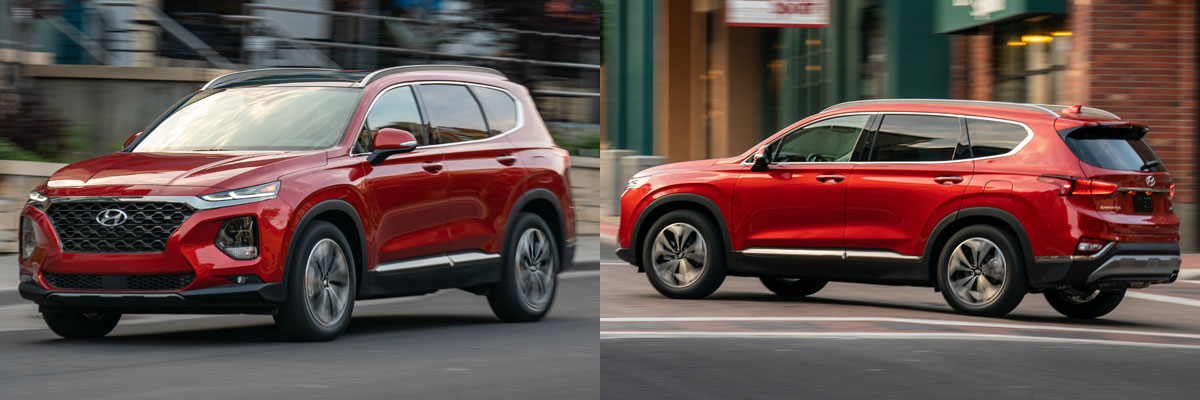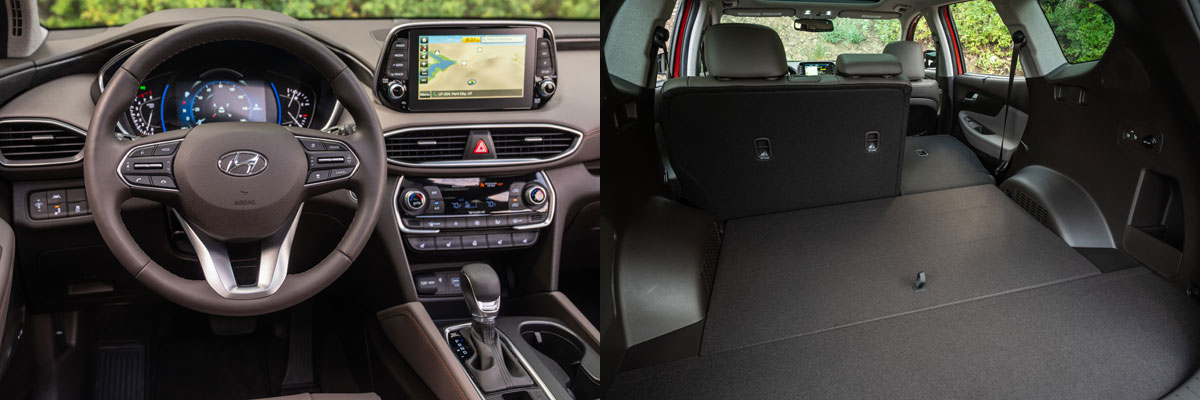For 2019 Hyundai shuffles its midsize crossover lineup a bit. All new is the two-row Santa Fe, which replaces last year's Santa Fe Sport. In the process, the returning three-row Santa Fe gets renamed to Santa Fe XL. (Which will be replaced later this year by the Hyundai Palisade). Got that?
What's important to note is that the 5-passenger Santa Fe is all-new for 2019, boasting larger dimensions, additional safety and convenience features and a new 8-speed automatic transmission. Competitors include the Chevrolet Blazer, Ford Edge, Honda Passport, Mazda CX-5, Nissan Murano, Subaru Forester and Toyota Highlander.
As mentioned, Santa Fe is slightly larger than the outgoing Santa Fe Sport. Interior room and cargo space are up slightly. Styling, inside and out, is completely new as well. Santa Fe gets standard Apple Car Play and Android Auto integration and forward collision warning and mitigation, blind-spot monitor, rear cross-traffic alert, drowsy driving warning and Hyundai's Safe Exit Assist, which will temporarily prevent a door from opening if a vehicle is approaching from behind.
Engines return unchanged. There's a 185-horsepower 2.4-liter 4-cylinder and a turbocharged 2.0-liter four that makes 235 horsepower. Both engines mate to a new 8-speed automatic and are available with front- or all-wheel drive. Towing capacity with the base four is 2,000 pounds and climbs to 3,500 pounds with the available turbocharged four.
Trim levels include SE, SEL, SEL Plus, Limited and Ultimate. All come with the base four and the turbo four is available on the Limited and Ultimate. Prices start at $25,500 for the front-drive SE and climb to more than $37,00 for the Ultimate with the 2.0T engine.

With a 0-60 MPH time of nearly 10 seconds, the base 2.4-liter engine doesn't provide much motivation. In addition, the engine is also somewhat coarse in acceleration and can seem like it's struggling to produce power. It's strange that Hyundai makes it standard across the board, given the engine's modest output. Thankfully, the 2.0T engine that is an option in the Limited and Ultimate provides better, though still barely class average acceleration. Most peg the 0-60 MPH time in the seven second range. The engine seems to lack power down low when accelerating away from stoplights, but quickly builds momentum in passing situations.
Both engines mate well to the new 8-speed automatic. Upshifts are nearly seamless and downshifts are prompt when called for in passing situations. The transmission does seem to have several top gears and always has the engine spinning at the lowest speed possible. The available all-wheel-drive system does not have a low range is not intended for severe off-road use.
EPA ratings on the 2.0T engine fitted with all-wheel drive are a mediocre 19 MPG city and 24 MPG highway. Those numbers fall short of class leaders by a few MPG. Thankfully, the turbo engine runs fine on regular-grade gasoline. In routine suburban driving, expect to average about 23 MPG overall. You might see as high as 26 MPG if you throw in a healthy mix of modest highway travel. Stuck in the city all the time? You will average about 21 MPG.
Hyundai stepped up its game with the Santa Fe's new suspension setup. Though it is conventional in design, it does a good job of providing Hyundai's traditional smooth and unfettered ride while gently introducing a bit of sophistication to the Santa Fe's handling capabilities. That said, the Santa Fe is no autocross champ, but there's enough athleticism to keep the Santa Fe out of the slow lane when climbing or descending mountain passes. The steering is nicely weighted and provides enough feedback on twisting roads. Brakes offer good stopping power and an easy-to-modulate pedal. In all, the new Santa Fe provides a comfortable and composed ride that's not afraid to tackle twisting roads or winding expressway on ramps.
Interior noise levels are relatively modest for the class. There's some wind rush at highway speeds around the A-pillars and, as mentioned, the base engine has an unsophisticated growl in hard acceleration.

With upscale materials, improved control layout and an available head-up display, the interior is completely new for 2019. Driver's face a large instrument panel with a mix of digital and analog gauges. It's somewhat programmable and easy to read, day or night. The new head-up display also includes blind-spot information, a nice plus. Center stack features a 7-inch touch screen and wireless charging dock. Ancillary controls are conveniently placed and intuitive in operation. One nice plus are simple controls for the climate and audio systems -- especially as more manufacturers look to blend those functions into the display screen.
Interior room is up with the 2019 redesign and so is overall comfort. The front seats are transformed from formless penalty boxes to nicely bolstered and supportive chairs with great long-haul comfort. Head and leg room are ample. Hyundai even took great pains to open up the greenhouse to improve outward visibility -- which is still somewhat blocked to the rear three-quarters.
The back seat is positively spacious for the class. Seats are well bolstered and fold quickly to increase cargo capacity. Getting in and out is a snap thanks to large door openings and a modest step in heights. Hyundai has added a unique safety feature called Safe Exit Assist system. Designed to enhance the safety of rear-seat passengers, Safe Exit Assist detects cars approaching from the rear and cautions passengers looking to exit the vehicle. If a passenger attempts to open the door when a car is approaching from behind, a visual and acoustic warning on the center cluster will alert the driver.
Cargo capacity tops out at 71.3 cubic feet. That's good, but not tops in the class. Still, with the rear seats in use, there's 40 cubic feet, which is nearly tops in the class. The hatch opening is quite large and there are a couple covered bins beneath the floor. Interior storage is good with lots of open and covered bins throughout. The map pockets have built-in bottle holders and there's a deep center console.
Bottom Line - The all-new Santa Fe is significantly better than the outgoing Santa Fe Sport. It's got more room, more features and a more sophisticated ride. On the negative side, it's best to forget the base engine and that means stepping up quite a bit in price and fuel economy is only mediocre. Given the glut of vehicles in this class, pricing is very competitive and Hyundai does offer an exceptional warranty. Shop around and find the vehicle that best fits your needs ... then negotiate for the best deal.
|
|